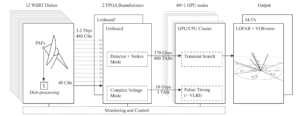The Apertif Time-Domain Data Release 2 (ARTS DR2) is hosted on the Apertif Long Term Archive and exposed to the community through the standard Virtual Observatory protocol. This section describes how the data products can be queried and accessed by using different applications.
User Interfaces
The science-ready data products are exposed through standard Virtual Observatory protocols to facilitate their access and exploration.
We recommend astronomers use the VO interfaces for data discovery. The data published in the VO can be accessed using a web browser at https://vo.astron.nl (how to access the data can be found here). Details on other protocols are listed below. These interfaces will redirect to ALTA file servers for data access where appropriate. ALTA is the Apertif Long Term Archive system.
In particular, the protocols offered are the Tabular Access Protocol (TAP), Simple Application Messaging Protocol (SAMP) and the Simple Image Access protocol (SIA). TAP and SAMP enables queries to explore the data in a tabular form using tools such as TOPCAT. TOPCAT is an interactive graphical viewer and editor for tabular data, it enables the interactive exploration of large tables performing several types of plotting, statistics, editing and visualization of tables. SIA enables the rapid display of images and cubes through all sky atlas tools such as ALADIN. ALADIN is an interactive sky atlas allowing the user to visualize digitized astronomical images/cubes and superimpose entries from astronomical catalogues or databases.
Data Usage Policy
Papers making use of this data should include the following acknowledgement:
This work makes use of data from the Apertif system installed at the Westerbork Synthesis Radio Telescope owned by ASTRON. ASTRON, the Netherlands Institute for Radio Astronomy, is an institute of the Dutch Research Council (“De Nederlandse Organisatie voor Wetenschappelijk Onderzoek, NWO).
In addition, they should cite these two ARTS papers:
- van Leeuwen, J. et al. 2023 (A&A 672, A117): "The Apertif Radio Transient System (ARTS): Design, Commissioning, Data Release, and Detection of the first 5 Fast Radio Bursts"
- Pastor-Marazuela, I. et al. 2024 (A&A submitted): "Comprehensive analysis of the Apertif Fast Radio Burst sample: similarities with young, energetic neutron stars"


